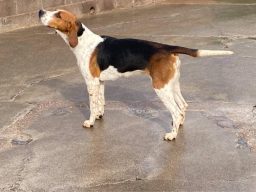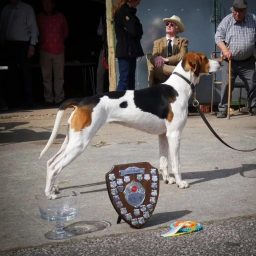Foxhound Varieties
While the current breed standard with the Kennel Club is an interim version it does give a basic outline of the breed. However, One must be mindful that these hounds are bred to have the athletic ability to hunt their quarry. With different qualities for their different countries. We explore these further below and so judges should be mindful of the varieties similar to that in the Basset & Dachshund
History of the Foxhound
Traits
Andy McIllraine once said “If you are not a hound person, it may be hard to understand” I wholeheartedly agree with him.
Often people do not realise that your hound does not believe they need you. Hard to understand – yes? No. Not really.
A human is a convenience to a hound, in the way Starbucks has a drive through or adding a website to your favourites. If you don’t have them you’ll get on just fine, however life is a little easier when they’re there.
Unlike other working dogs such a retrievers or collies who work with you, the shepherd can’t move sheep without his dog & the dog can’t move sheep without the shepherd. They are programmed to keep owner/handler happy.
The foxhound? Whole other story! They are independent. Some varieties are fiercely independent (the Welsh & fell). The foxhound will (historically) have gone off in their pack to the edge of a wood or covert and use their nose to find the foxes scent. They do so with no instruction from their master.
They make their own decisions. They pick up the scent of the fox and run. They move & turn. They climb hills. Jump fences. All on their own initiative. Infact, they command their master with their cry.
Highly intelligent as they might be, the foxhound won’t do as it’s told just because you demand it. They find it a cooperative effort. They need to know what’s in it for them.
Don’t get me wrong. They make superb pets & truly encourage anyone to consider them. However, they aren’t a first time dog owner pet. Probably not even a 2nd time dog owner. They are often referred to as stubborn, like many other types of hounds (dachshunds in particular spring to mind).
Are you still with me? Are you starting to understand?
Their priorities are incredibly different to any other breed I have worked with. Example, I let my girls roam whilst I do kennels & stables. They’re never far from me, when I call they come. But not directly. They don’t arrive & sit patiently awaiting their next command. They appear. They show me they have listened but they remain independent. Following their noses for whichever piece of animal muck might be closest.
One must remember that this is how they should be. A huntsman doesn’t want a hound at his feet all day. They need to be confident to take themselves off.
You may now be wondering “so how do I make myself the priority”. Sorry to tell you it’s unlikely that you will. At best they will see you as family, as Adam puts it, a sibling or good friend. One who has a give & take relationship, a balance. You won’t get it 100% right everytime. However if you start to understand how a hound thinks, you’re already a good part of the way there.
Foxhound Types
The Welsh Hound
Easily identifiable by its woolly coat, the Welsh hound has a more wire like coat giving a fluffy appearance. Often found to be lighter in colour – Sir Edward Curre bred white hounds on the edge of Wales that became infamous for their cry. Still deep of chest, this time with a lower set ear that should cover the muzzle when head down hunting.
Black & Tan Hound
Commonly mistaken as a Bloodhound despite the difference in earset, the black & tan foxhound were found in the Dumfriesshire Kennels until 2001. Founded by Sir John Jardine after WW1.
These particular hounds were bred from the English Foxhound, Bloodhound & Grand Bleu de Gascogne mix meaning they were larger in appearance than the Foxhound itself.
This type of Foxhound is possibly the rarest of them all, although some bloodlines do still exist in the Peak District & France this hound is now extinct.
The Old English Foxhound
A cousin to the American foxhound, there are only a few remaining old English packs in the UK. A good reference would be the Duke of Northumberland’s pack The Percy Hunt. A maximum of bone in this big solid hound would be bred for the arable country where going can be deeper. Deep of chest with high set & strait stern this hound would have good round feet.
Modern English
LAs eluded to by its name the modern English as lighter and smaller version of the old English. Often referred to as a hill hound. This is what most people would recognise, coming in a variety of colours these hounds are often smaller and lighter of bone than it’s OE counterparts giving a rangier movement but still with straight front, deep chest, larger squared skull and good round feet These are often crossed with the fell hound to create the “hill hound” a more athletic version of the modern English with a much lighter frame & independent nature – a hound VERY common in the North of England. A good example would be Charlie Shirley-Bevans Tynedale hounds.
The Fell Hound
Native to the Cumbrian fells these packs are hunted on foot & so must be far more independent. These hounds can be smaller in height & frame with a longer toe giving a “hare foot” for this more difficult terrain. Often fell hounds can be recognised by their pointer nose & a badger colouring. Much lighter in frame with deep chest.
The fell hound is often bred into hill hounds for a more independent way.






©Copyright. All rights reserved.
We need your consent to load the translations
We use a third-party service to translate the website content that may collect data about your activity. Please review the details in the privacy policy and accept the service to view the translations.